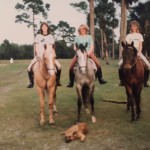Back in another life, I flew without wings. All my free time was on the back of a horse, aiming toward ditches, brush piles, or neatly stacked poles, and cantering forward until hooves parted with earth and we sailed upward, buoyant for brief glorious moments.
Most of the time, this is not a point-and-shoot exercise. On TV it looks like the rider balances primly with her shiny boots in the stirrups while the horse bounds around the ring or through the field like a lamb, vaulting obstacles in a neat line. Inside the rider’s head, it’s a different story.
It’s all about timing, the length of a horse’s canter stride and how many of those 3-beat strides fill the space between one jump and the next. If it’s a tricky distance, you might go faster or slower to shorten or lengthen the stride. Just as you’re taking off, you shift your weight forward and slide your hands up his neck a bit, loosening the rein so you’re not jabbing him in the mouth as he stretches over the jump. Would a horse naturally do this on his own? Generally, no, not even to escape an enclosed pasture. Horses are by nature fairly lazy and would much rather swish flies and graze in a sunny field all day.
On one sticky Florida afternoon, I navigated through a cross-country course with obstacles made from tree trunks and other “natural” barriers. My horse was a stocky palomino with a mid-section like a barrel. He had been a poky western pleasure mount before arriving at  the farm in his reluctant new role as a hunter jumper, and his strides were clipped, his manner resentful, and his driving force was to avoid exertion and retire to the stall as soon as possible.
the farm in his reluctant new role as a hunter jumper, and his strides were clipped, his manner resentful, and his driving force was to avoid exertion and retire to the stall as soon as possible.
My calves ached from the constant “encouragement” this horse required to make it up and over each jump in the field. He’d obediently break into a misleading canter, only to pull up short just before the jump and pop over it grudgingly from a stand still, leaving an unprepared rider wobbling in the saddle. Despite knowing this, I let my guard down at the water jump. It was just a two foot ditch flanked by railroad ties, like hopping a crack in the sidewalk. He could have trotted over it easily, and in fact, that’s just what I expected him to do. Pridefully, I thought, this one was easy. We all know what proverbially follows pride.
Inches before the simple jump, he stopped dead, planting his hooves like a mule. His muscled hind end gathered up behind him like we’d just roped a calf and he was in full skid. I continued on without him. In what I like to imagine was a graceful somersault, I tumbled over his ears and down, cracking my ribs across the railroad ties before flipping backwards into the water.
Icarus, fallen.
I lay on my back in the mud, feeling like a bird must after it has flown full-force into a plate glass window. Submerged, I looked up through about three feet of water, my arms pinned against my throbbing ribs by the solid sides of the jump. Thankfully, I did not try to breathe. I could not even gasp, as all air had been forced from my lungs on impact. A muted sort of quiet surrounded me, like when you sit like a yogi on the bottom of a swimming pool, testing how long you can hold your breath. The blue, cloud studded sky rippled overhead and I saw my horse’s nose as he peeked over the edge, certainly not concerned for my well-being, but more to inquire if we were now, in fact, done for the day.
In short measure, my companions rushed over to hoist me, dripping and muddy, out of the ditch. Rule number one is get back in the saddle. Never end on a bad note. So, up I climbed, each breath ragged and painful, and we approached the jump again. He gauged from my black mood that he should not repeat his little trick and skipped over it this time like he was in a girlish game of hopscotch. Afterwards, I sullenly led my horse back to the barn, water squelching in my boots the whole way.
For a time, while my ribs healed, my wings were clipped. It was one of those formative childhood moments: invincibility is imaginary. While I preferred the air to earth’s tether, the air was risky; lying face-up in a mud hole was always a possibility.
It’s tempting to cling to the sure thing, the comfortable, in lieu of that risk. Sometimes we even prefer our own painful mud hole to climbing out to face what might be humiliation or vulnerable exposure. It’s quiet in there, and we’re kind of used to it. We tiptoe along, watching others achieve goals, be adventurous, learn a new skill, go on that first date after a lost relationship, craft their art.
The view from down in the ditch is less than inspiring. We placate ourselves, pointing out the blue sky and sunshine, but it’s a stifled view we’re used to, settling for a rippling opacity, void of fresh air and birdsong. We cannot be afraid of bruised ribs or bruised egos. Take a breather after the hard knocks, but bruising is only a reminder of what not to do the next time. Because there should be a next time! We are not meant to be ditch dwellers. We are meant to test our mettle, reach beyond our grasp, experience abundance and taste what it is to fly, even without wings.









Love it! The movie Zootopia has a song in it by Shakeera called “Try Everything”. Same idea as your piece. I totally agree!